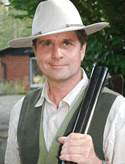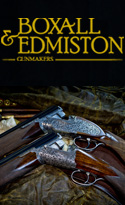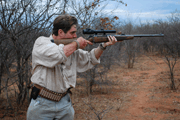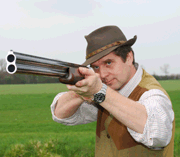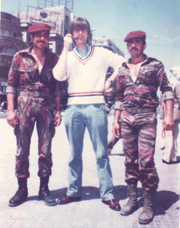A Brief History of the Sporting Gun
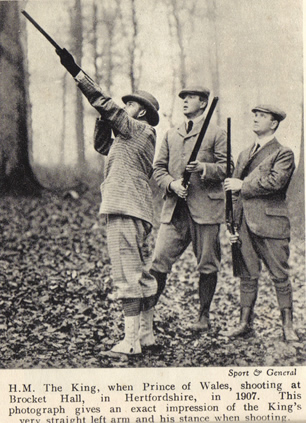 During the early 1600s, dedicated fowling pieces began to be made in some quantity in England. Both short and long types evolved. The distinctive feature of the long fowler, as one might guess, was its extremely long barrel (anything up to seven feet in length). These guns were made in a variety of bore sizes and appear to have been the gun of choice for wildfowling at longer ranges. It being common fallacy of the era that ultimate range and length of barrel were synonymous. The shorter fowlers, field fowlers as they have been termed, were used when a handier weapon might be required and are the direct ancestor of the modern sporting shotgun.
During the early 1600s, dedicated fowling pieces began to be made in some quantity in England. Both short and long types evolved. The distinctive feature of the long fowler, as one might guess, was its extremely long barrel (anything up to seven feet in length). These guns were made in a variety of bore sizes and appear to have been the gun of choice for wildfowling at longer ranges. It being common fallacy of the era that ultimate range and length of barrel were synonymous. The shorter fowlers, field fowlers as they have been termed, were used when a handier weapon might be required and are the direct ancestor of the modern sporting shotgun.
Gervase Markham, tells us in his much quoted book, Hunger’s Prevention: or the Whole Arte of Fowling Water and Land (published in 1621) that the Fowling Piece shall be the best: “which is of the longeft barrell, as five foote and a halfe, or fixe[six] foote[during an era when military muskets typically had 4 foot barrels], and the bore indifferent, afome [some] what under Harquebufh”[i.e. probably under 12 bore]. His preference was for a gun with “fier locke [wheelock]or Snaphaunce [a lock which operates on the flint and steel principle], rather than a cocke and tricker [matchlock], for it is fafer[safer] and better for carriage, readier for vfe[use] & keepes the powder dryer on all weathers, whereas the very blowing of a coale is many times the loffe[loss] of the thing aimed at”.
Markham noted the superiority of “haileshot or drop-shot” as better than “single or doble bullet”. This might seem an obvious point to the modern reader, but lightweight, small-bore, birding pieces were also in use circa 1620 (and had been for more than 100 years). Usually smoothbore, but sometimes rifled, their use with ball was associated with the sport of bird shooting, whereas, fowlers, long or short, were cruder tools primarily intended for pot-hunting. As far as fowling was concerned, shooting methods were crude, Markham advocated the use of a stalking horse (and for those who could not afford the real thing, he suggested the manufacture of an artificial one from canvas). Birds were shot on the ground or water. Consistent wingshooting was not yet a practical possibility with firearms (although one suspects it must have been occasionally attempted).
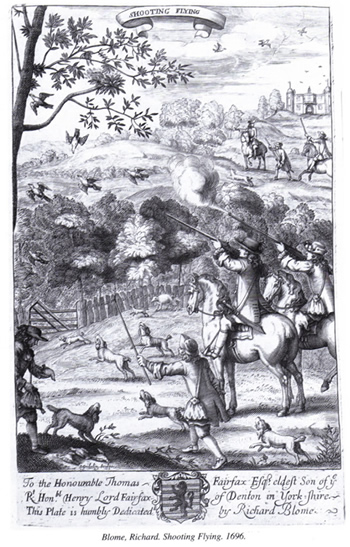 There is a portrait of Sir Thomas Southwell of about 1630 at the Royal armouries at Leeds in England which shows him standing with a heavy snaphaunce fowler with a barrel of about 5 feet in length, another, very similar gun (apparently brought to America by the Forbe’s family) is in the Smithsonian in Washington dated at about 1640. Both have a similar tulip form of muzzle (but this is only a decorative feature, the bore itself being parallel). Claude Blair, former Keeper of Metalwork at the Victoria and Albert Museum, drew attention to a long barrelled fowling piece in the Curtis Museum at Alton in Hampshire(but which now resides in the Havant museum, near Portsmouth). Of approximately 16 bore, the barrel appears to be about 5 ½ feet long with a muzzle which appears to be flared. In discussing this gun and a birding piece with a tiny “scewed” bore of .187”, Blair noted: “The fowling piece appears to be what we would now describe as a shotgun, and into this category can be placed the majority of smooth-bore sporting-guns produced during the seventeenth century…These ‘long fowlers’ seem to have been particularly favoured in both England and New England”.
There is a portrait of Sir Thomas Southwell of about 1630 at the Royal armouries at Leeds in England which shows him standing with a heavy snaphaunce fowler with a barrel of about 5 feet in length, another, very similar gun (apparently brought to America by the Forbe’s family) is in the Smithsonian in Washington dated at about 1640. Both have a similar tulip form of muzzle (but this is only a decorative feature, the bore itself being parallel). Claude Blair, former Keeper of Metalwork at the Victoria and Albert Museum, drew attention to a long barrelled fowling piece in the Curtis Museum at Alton in Hampshire(but which now resides in the Havant museum, near Portsmouth). Of approximately 16 bore, the barrel appears to be about 5 ½ feet long with a muzzle which appears to be flared. In discussing this gun and a birding piece with a tiny “scewed” bore of .187”, Blair noted: “The fowling piece appears to be what we would now describe as a shotgun, and into this category can be placed the majority of smooth-bore sporting-guns produced during the seventeenth century…These ‘long fowlers’ seem to have been particularly favoured in both England and New England”.
The new method of shooting flying, introduced in England from France in the late 1600s, encouraged the development of the shorter barrelled gun. It may be that the harsh game Act of 1671 (which restricted shooting to freeholders worth more than £100 a year) and the fashion for partridge shooting at the time were also factors in the evolutionary process, and one could argue that the neat form of the delicate birding piece had its influence too. Whatever the answer, the shotgun - a smoothbore firearm intended for use with shot - was evolving into a piece of sporting equipment. The1686 edition of The Gentleman’s Recreation tells us that the ideal barrel length for shooting flying was “about four Foot and a half in the Barrel, and of a pretty wide Bore something under a Musket”[the standard musket size from the 1630s was 12 bore].
By the late seventeenth century, some very elegant, well-balanced, weapons were being made for wingshooting. I had the chance to handle a beautifully balanced flintlock gun of about 1700 in the Tower of London some years ago thanks to the ever helpful and enthusiastic Keeper of Firearms, Graeme Rimer. Made by John Shaw, it was about 12 bore with a barrel approximately four feet six in length. Although this specimen did not look especially refined as far as its external finish was concerned, I was amazed by its delicacy and fast handling qualities). The Royal Armouries also possess a number of sporting guns intended for shooting flying from the ‘cabinet’ of the Duke of Brunswick. All circa 1700, they are by different makers, but all have flintlocks and barrels of about four and half feet. Their stocks are especially interesting in that some are heavily cast-off and show a sophisticated understanding of gun-fit.
Four foot barrels became typical in sporting guns of the first quarter of the eighteenth century [returning to the military standard]. By mid-century 36” was common, though shorter barrels were not unknown on fowling pieces intended for use in coverts. John Nigel George notes a 30” 12bore (flaring at the muzzles to a 9) by Coombs of Bath which was in the famous Neal collection. It may be dated to 1744 by the hallmarks of its silver decorations (though its lock, which may have been replaced, appears to be of considerably later date).

In the 4th (1785) edition of The Art of Shooting Flying, Thomas Page gives unambiguous advice on barrel length: “It is necessary for any gentleman who sports much to have two guns: the barrel of one about two feet nine inches[33”], which will serve very well for the beginning of the season, and for wood-shooting; the other about three feet three inches [39”], for open shooting after Michaelmas: the birds by that time are grown so shy, that your shoots[sic] must be at longer distances. But if you intend one gun to serve for all purposes, then a three foot barel[sic] (or thereabouts) I think most proper.”
Page advocates a relatively small bore size of 5/8” (.625 - about 20bore) and praises the safety and lightness at the breech of Spanish barrel - “I never saw a gun of Spanish form burst near the breech”. He chose his words carefully, however, “Spanish form” indicating a smoothbore barrel of small-bore, “nearly a cylinder” with a breech dimension which is not greatly different from the rest of the tube - by way of contrast, the typical English barrel was “very stout” at the breech but thin forward of it. The Spanish form continued throughout its length “with a more regular thickness” which he opined not only resulted in a safer tube, but one able to “carry the shot smartly”. In other words, it appears that Page believed that the thickness of the tube effected its shooting qualities - the more uniform, longer tube, according to his theory, offering maximum range. According to him, the advantage of the then much more expensive Spanish barrel had little to do with its country of origin and everything to do with its shape and length.
An Essay on Shooting of 1789, an adaptation of a French work but with important additions relating to English gunmaking, also demonstrates a scientific approach. The anonymous author quoting the “able mathematician and engineer” Benjamin Robins experiments on musket barrels (which suggested little benefit to very long barrels) before describing in considerable his own paper penetration trials of barrels varying in length from 28 to 66 inches from which he concluded that barrel length within this range made no discernible difference. “So great is the change in opinion of late, with regard to the proper length of gun barrels,” the writer the Essay notes, “that many gunsmiths will now tell us, that short barrels carry farther than longer ones; and the reason they give is the greater friction of the ball or shot in passing through a long barrel…The barrels which we ourselves employ, and which we have found to answer best for every purpose, are from 32-38”…”
On the subject of Spanish barrels - which like barrel length was evidently a ‘hot’ topic in the sporting literature of this era - The Essay opines: “Not withstanding the great reputation of Spanish barrels…they are little used in France, and still less in England, their awkward form, and their great length and weight being strong objections to them, especially since they have begun to make their pieces so very short and light [my italics] in these countries. As from our own experience of Spanish barrels, we are convinced, that the avidity with which they are sought after by some persons, and the extravagant prices that are given for them, proceed more from a fancied, than from any real superiority they posses over those made in this country [England].” The reason is rather different to Page, but the conclusion is the same - they ain’t worth the money.
Advent of the double gun
Over and under shotguns and combination guns had been made in the previous century, but the side by side emerged in France in the first half of the eighteenth. Its idea seems to have spread quite quickly. There is, for example, a 1737 specimen by the Danish maker Valentin Marr in the Tojhusmuseet in Copenhagen. It has a bore of about 40 and the barrels are joined by a top rib rather than by hoops or plates as seen in most earlier (and some subsequent) double guns. Griffin, the fashionable London maker made at least one side by side circa 1750-60. It is illustrated in George’s English Guns and Rifles and was recently sold as part of the Neal collection. As far as I am aware it is the first English double. Development of the double gun was, however, hindered by a resistance to the style of gun in England and a variety of technical factors relating to barrels and breeching.
Nock’s patent breech
Henry Nock’s “patent breech” of 1787 which it may be said without exaggeration revolutionised firearms ballistics.Nock’s great advance combined a chamber in the breech plug and an ante-chamber drilled cross-wise from the barrel touch hole and closed on the other side with a screw plug. Though it might seem a rather trivial development, Nock’s breech was, in fact, an invention of the greatest importance. Powder was now confined loosely in the ante chamber. When the priming ignited, there was an explosion rather than mere burning as before. Ignition and combustion of the main charge were much improved; less powder was needed. Wingshooting became easier (because of the reduction in delay between pulling the trigger and the gun firing) and barrels could be chopped down without loss of performance. The double-barrelled fowling piece began to be a practical proposition. And, as a result of these developments, a new style of sporting gun appeared towards the end of the Eighteenth century, typically half-stocked, with one or two barrels of about 30”.
Other refinements were made in this era to improve the function of the lock such as a roller bearing between the steel and ‘feather spring’ and a friction-reducing link between mainspring and tumbler. The waterproof pan was introduced, as were a variety of new safety features. During the early nineteenth century, makers like Manton threw all their genius into improving the form and function of the flintlock sporting gun, refining it by further subtle improvement into an extremely sophisticated and elegant weapon. As well as the improvements to breech and lock, the elevating sighting rib was introduced (another Joe Manton innovation - it prevented guns shooting low), bend was much reduced (reducing felt recoil and aiding wingshooting) and subtleties of grip and comb shape evolved. The basic form of the gun we know to today was worked out in this era and guns of this epoch still impress when one brings them up to eye and shoulder.
Percussion ignition
 After the flintlock and patent breech, the next great step forward was the percussion lock (which is considered in greater detail in the cartridge section). In this, a tiny quantity of detonating compound-typically fulminate of mercury or potassium chlorate* - was contained in pellet, tube or cap, and detonated by a hammer blow. Percussion guns or “detonators” as they were called, were very similar to flintlocks in most other respects and consequently flintlock guns were readily convertible to the new system, which encouraged its rapid adoption (although there was a requirement for subtle differences in barrel boring to suit the new, faster, mode of ignition). The percussion system, although it altered the basic form of the gun but little, made a significant contribution to its ease of use. It was not just a question of convenience and reliability. The delay between pulling the trigger and the main charge’s firing was yet again reduced. This eliminated the need-which there must have been with most flintlocks-to sustain a lead in front of the target while waiting for the propellant to ignite. Hawker, an expert with both guns and a very accurate chronicler of technical detail noted that the lead required with the new guns was half of what was needed with a flint gun: “If you have a detonator, make only half the allowance; that is where you would fire six inches before a bird with a flint [evidently he was seeing his allowance at the muzzles, not at the bird], fire only three inches with a detonator”.
After the flintlock and patent breech, the next great step forward was the percussion lock (which is considered in greater detail in the cartridge section). In this, a tiny quantity of detonating compound-typically fulminate of mercury or potassium chlorate* - was contained in pellet, tube or cap, and detonated by a hammer blow. Percussion guns or “detonators” as they were called, were very similar to flintlocks in most other respects and consequently flintlock guns were readily convertible to the new system, which encouraged its rapid adoption (although there was a requirement for subtle differences in barrel boring to suit the new, faster, mode of ignition). The percussion system, although it altered the basic form of the gun but little, made a significant contribution to its ease of use. It was not just a question of convenience and reliability. The delay between pulling the trigger and the main charge’s firing was yet again reduced. This eliminated the need-which there must have been with most flintlocks-to sustain a lead in front of the target while waiting for the propellant to ignite. Hawker, an expert with both guns and a very accurate chronicler of technical detail noted that the lead required with the new guns was half of what was needed with a flint gun: “If you have a detonator, make only half the allowance; that is where you would fire six inches before a bird with a flint [evidently he was seeing his allowance at the muzzles, not at the bird], fire only three inches with a detonator”.
Breechloaders
Breechloading firearms date back to very early times. Some ancient canons were breech loaders, Leonardo sketched a design for a screw breech canon and Henry the VIII possessed a number of breechloading, wheel-lock, sporting guns. Abraham Hill took out an English patent for pivoting breech gun in 1664. Henry Nock the inventor of the patent breech also created a musket with a tipping breech and one might cite many other early breechloaders. However, breechloaders using fully self-contained cartridge were developed in France in the first half of the nineteenth century. They had become possible because of Forsyth’s percussion, but another genius now enters our story - Pauly, a Swiss-born gunmaker and inventor who worked in Paris. A visionary by any standard, he patented the first practical breechloader using a self-contained, rimmed, centrefire cartridge in September, 1812. His shotgun and rifle had a fixed barrel and hinging breech (the Pauly pistol had a hinging barrel) and used a partially consumable paper and card cartridge with a metal head. Fulminate priming powder was tamped into a recess in the cartridge base to provide the means of ignition.
Robert, a Paris dentist influenced by Pauly, developed a hammerless gun in which the breechblock was raised (in similar fashion to the Pauly) to insert a self-contained cartridge which had a long, tube-like primer projecting from its base. His agent, Augustus Demondion, took out a British patent in 1831. A year later, Casimir LeFaucheux patented his pivot breech (‘drop-down’ or ‘break-action’ as it would be called in England), double-barrel, percussion gun in France and, in 1836, a crude pinfire cartridge. In 1851 an improved Lefaucheux pinfire gun and cartridge were exhibited at the Great Exhibition at the Crystal Palace in Hyde Park. Lefaucheux's gun-“The French Crutch Gun”, as it was rather disparagingly called in England-had a rotary locking system involving an underlever positioned beneath the action bar and a single bite on the barrel lump (later, the gun was further improved with double bites).
In the 1850’s, Lancaster offered a stronger, but more expensive, action operating on a slide forward and hinge down principle and, perhaps more significantly, an improved “basefire” cartridge. The latter was superior in most respects to the pinfire type, but had no protruding pin to allow for easy manual extraction; consequently, Lancaster guns have an extracting device built into the action.* Innovative though they may have been, early breechloaders were frequently considered weak, heavy, and lacking in power. In1858 and 1859, in trials arranged by J.H.Walsh of The Field, muzzle-loaders were proven to be ballistically superior by a small margin. W.W. Greener’s father, William, and other conservative authorities, continued to champion their cause (which may well have led to a split within the Greener family) well after this date.
The slight ballistic inferiority of the breechloader would not last long. Developments during the second half of the nineteenth century were fast and furious (they are well catalogued in the works of Walsh and W.W.Greener). Some stand out as milestones. François Eugene Schneider’s “snap action”(patented in Britain in1861) allowed a gun to be closed and bolted merely by bringing the barrel to the action face. The mechanism involved a round bolt’s passing through the standing breech engaging a recces in the barrel lump. It was later modified by the English gunmaker Daw in 1862* and further improved by Purdey. On the 2nd of May, 1863, that famous gunsmith patented his “double bite” action, with a sliding bolt operating on twin bites-a system near universal in modern side by sides. Two years later, William Middleditch Scott patented the equally important spindle which allowed the Purdey bolt to be operated by a conveniently placed lever on the top strap of the action (initially it had been operated by lever in front of the trigger guard). The combined concepts of the Schneider, Purdey and Scott inventions made possible the multiple-bite, snap action which is seen on nearly every side-by-side gun today.
Early breechloaders, with a few notable exceptions, had external, manually cocked, hammers. These left a great deal to be desired as far as safety was concerned and meant that the hammers would have to be raised to half cock when carrying or closing a loaded gun (otherwise the striker would be resting on the primer, under the force of the hammer) and before opening the fired gun. Rebounding hammers were patented by Stanton in 1867; with these, the hammers automatically rebounded to the half cock-position after firing - a significant improvement. Hammers on early breechloaders tended to be rather high often looking like “rabbit ears” later guns had neater, lower hammers, which were not only safer (because they were less vulnerable to locks) but less distracting to the eye.**
Once the means of hinging and bolting the gun had been perfected, the next stage was the development of a self-cocking action in which the hammers were incorporated inside the action body. Theophilus Murcott of the Haymarket, London, is generally credited with the first hammerless gun (patented 1871), known in the gun trade ever since as Murcott’s Mousetrap. In it, an underlever was used to open the gun the gun and cock the locks. It was rather too complicated to succeed. Needham patented a hammerless, barrel-cocking gun which was also the first ejector in 1874. There are, however, two hammerless, barrel cocking designs which stand out above all others: the brilliantly simple Anson and Deeley “boxlock” of 1875, which recocked itself on opening, and the Purdey/Beesley style* of hammerless “sidelock” of 1880, which cocked on closing and which incorporated a self-opening feature (powered by its own mainsprings). Early Anson and Deeley guns used a Westley Richards doll's head extension for bolting, but the Purdey Double bite was later added to create a classic action which has been copied by hundreds of makers since.
While action types were being perfected, so were barrel boring and choke. W.W. Greener popularised choke in England and finally proved its superiority at The Field’s gun trial at Wimbledon in 1875. Smokeless powders first came into use in the 1860’s and 70’s and they were used in sporting shotguns before anything else (although it still would take a generation for them to become popular). The final perfection of the side-by-side gun concerned its ejector mechanism. This might be contained in the action itself or in the forend. The former style was seen in Needham’s gun. The latter system became dominant and was perfected, most notably, by Southgate, although many others might be cited.
By about 1890, the form and mechanism of the side-by-side sporting shotgun was firmly set and our story must now move across the Atlantic. America is the country concerned more than any other with the development of the repeating shotgun. Mass production methods dated from the early years of the republic, but had been refined and generalized during the Civil War. Colonel Colt’s pistols, and the Henry and later Winchester lever action rifles became very popular. The murderous devices of Dr. Richard Gatling and Hiram Maxim were also significant. Inevitably, similar methods of manufacture and ideas where applied to shotguns.
Spencer’s pump action design patented in 1885 was one of the first repeating shotguns (see more on repeaters here) intended for use with normal cartridges (development of such guns had been impeded by irregularities in cartridge manufacture). Winchester applied their lever system to shotguns in the sturdy Model 1887 (and later in the Model 1901) but it was the Winchester Model 1893 pump, designed by John Moses Browning, that really dictated the future. The Model 1893 was fast cycling and reasonably well balanced although, unlike the Spencer, it had an external hammer. Thirty thousand were made before the 1893 was replaced by the even more successful, indeed legendary, Model 1897. This was a modification of the ’93 with a stronger action and side ejection. It is interesting to note that it was especially intended for use with smokeless cartridges which the earlier gun had not been. Later advances in repeaters put the hammer back inside the receiver and harnessed recoil or propellent gas energy to cycle the gun. Again it was John Moses Browning who led the way.
All that remains to be considered is the over-and-under. Contrary to the modern idea that stacked barrels are a recent format, some of the earliest double guns were built on the over/under principle. ‘Wender’ over and unders, where the barrels were rotated about a fixed pin, were being made in the middle 1600s and continued to be made in the eighteenth century and during the Napoleonic years in France (the Emperor himself gave a Wender over and under made by Le Page, the famous Parisian gunsmith, to King Frederick Augustus of Saxony in 1808). The great gun historian, W.Keith Neal, had an English, over and under gun of this type of about 1660 and a fixed barrel Dutch over and under duck gun of about 1680 in his extensive collection. In the Tojhusmuseet in Copenhagen (an extraordinary collection, the scale of which is hard to describe), there are a number of interesting, early, over and unders. These include a gun by Cunet of Lyons dating to 1660 and another, a 33 bore of 1725 made for shooting flying, by Peborde of Paris and in which the barrels are combined by plates.
John Rigby, made sophisticated single trigger, over-and-under sporting guns in the 1830’s, Walsh, another Dublin maker, made at least one over and under rifle-shotgun in the same era (it combined a 40 bore rifle with a 16 bore shotgun on top). Beretta were making muzzle loading over-and-under shotguns in the first half of the nineteenth century, and breechloading, centrefire over-and-under combination guns were seen in Germany from about 1870. Geoffrey Boothroyd puts forward a persuasive case that these guns, especially the Bockbüchsflinten (which placed a rifle barrel under a shotgun barrel) were the progenitors of the modern over-and-under. However, they were bulky guns and had a fairly high profile due to their full-width hinge pin. W. W. Greener patented his side-opening Wedgefast over-and-under shotgun in 1873 and made various over-and-under rifles on the same principle.* Dickson is well known for his side openers, the first of which was made in 1888, and this unusual style has been made in small numbers ever since.
Ian Crudgington and David Baker note an interesting French patent of 1889. Registered by Paul Brun-Latrige, it details the mechanism of a low-profile over-and-under in which the hinge point of the barrels is located between the tubes near the action knuckle. The gun is equipped with external wedges at the barrel shoulder which locate in recesses in the action walls in a manner not unlike a modern Beretta. The conventional under-barrel lumps and hooks were eliminated. The London firm of Boss came up with something much more sophisticated-and subsequently much more successful-in 1909. Like the Brun-Latrige, the Boss dispensed with under-barrel lumps, but in a sidelock design with a brilliant locking system incorporating wedges inside the action walls (which engage with lumps positioned either side of the bottom tube). In addition, two small bolts protrude through the action face, locating in square-cut bites to either side of the bottom chamber mouth.*
However, the man who really popularised the over-and-under was John Moses Browning, who produced his famous “Superposed” design after the First World War. It is a landmark in sporting gun design, manufactured and much copied to this day. Browning returned to the full width hinge pin but managed to keep the overall action height reasonably low nonetheless. Unlike the Boss and Woodward, the Browning design was a boxlock. It could be made by machine (although finishing by hand was required) and therefore at a much reduced cost. It remains one of the greatest sporting shotgun designs of the last hundred years.
The Shotgun-a chronology of patents and major developments
[P=year of patent. British patents unless otherwise indicated.]
Circa 1750 First English side by side with barrels joined at breech and top-rib appears
P1787 Henry Nock: patent breech.
P1806 Joseph Manton: elevating rib (patent later challenged).
P1807 Rev. Alexander Forsyth: percussion lock.
P1812 Samuel Pauly: fixed barrel breechloading gun using a metal based, partially-consumable cartridge with centrally positioned fulminate detonator.
P1820 (France) François Prelat: percussion cap (although caps were in use before this).
P1828 (France) Pottet: central fire cartridge, with central nipple for percussion cap.
P1831 Demondian patents Robert's hammerless breech loading with tube cap, self contained cartridge in Great Britain.
P1832 (France) LeFaucheux : pivot breech, double barrel, percussion gun.
P1836 (France) LeFaucheux: pinfire cartridge.
1838 Dreyse: long needle fire gun (priming attached to base of wad or bullet).
P1846 (France) Houllier: gas-tight, base wad, cartridge.
1851 LeFaucheux’s improved, drop-action, pinfire gun with improved cartridge is displayed at the Great Exhibition in the Crystal Palace.
P1852 Joseph Needham: hammerless, double barrel, needlefire shotgun (primer at base of cartridge).
1850’s Charles Lancaster: “basefire” gun developed.
P1861 François Eugène Schneider: obtains British patent for his new, double-barrel, snap-action sporting gun with extractor.
1861 Daw purchases patent rights to Schneider gun (and patents his own improvements in 1862).
From 1861 Daw develops centrefire gun and centrefire cartridge based on Schneider patent and sues Eley brothers when they start to manufacture a similar centrefire cartridge. His attempt at a monopoly of the centrefire principle is rejected by the courts, although part of his claim relating to a specific type of triangular primer anvil is upheld.
P1863 James Purdey: double bite action with sliding bolt.
P1865 William Middleditch Scott: top lever and spindle (which combined with the Purdey double bite creates the bolting and opening system used on the vast majority of side by side guns).
P1866 William Pape: describes choke as part of a specification for a new double-bite snap action gun (most modern authorities do not believe he actually invented the concept).
P1866 (U.S.A.) Sylvester Roper: revolving magazine, repeating gun.
P1867 John Stanton: rebounding hammer lock.
P1868 (U.S.A.) Sylvester Roper: interchangeable chokes.


